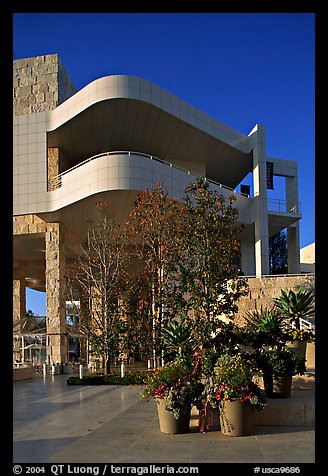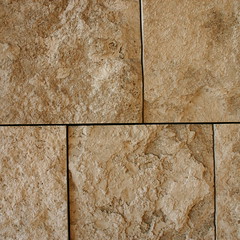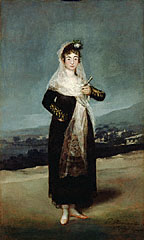
GETTY MUSEUM in L.A. DEC. 2005
We came to L.A. to visit Avi and to sightsee a bit. The main sightseeing was the Getty Museum, which was spectacular. It opened at its current site 8 years ago, just off of Hwy 405 on the northwest end of Los Angeles.
The Getty is now in two sites, with the Greek and Roman antiquities soon to be in view in the Malibu center. The Malibu center is the original site which is now being renovated. Getty had lived there and made it in the form of a Romanv illa. The Getty's main purpose is for antiquity research. The museum is an amazing gift to the community by Getty. Entrance is free and the only charge is $7 for parking for those who do not come by bus. Visitors take a tram up the hill through hundreds of planted live oaks.
At the top, we first saw a short movie on the history and an overview of the museum. Then we decided to go on a garden tour, which turned out to be an architecture tour also. The buildings and greenery around them were designed by the architect, Richard Meier. The gardens were designed by an artist. The results are quite amazing. Meier positioned the buildings along a natural ridge in the hilltop The views from the hilltop were spectacular too.


center gardens--an azalea maze
The main stone for the buildings is travertine, a type of limestone, so that is why the stone looked a bit like Jerusalem stone. The beige-colored stone1.2 million square feet of it—is one of the most remarkable elements of the complex. I was told that it sometimes has a pinkish hue at sunset if the light is not too bright. The 16,000 tons of travertine are from Bagni di Tivoli, Italy, 15 miles east of Rome. Many of the stones revealed fossilized leaves, feathers, and branches when they were split along their natural grain. We saw a number of the fossilized leaves too--quite amazing. The designer put these blocks in specific ways in different buildings.

The following gives you an idea of the complex, situation on top of a coastal hill.


ART ON DISPLAY: The galleries at the Getty Center are housed in the Museum's five exhibition pavilion. The North Pavilion presents Classical Connections, a small selection of antiquities, as well as paintings and sculpture dating up to 1600 and decorative arts dating up to 1650.The East Pavilion features primarily 17th-century Baroque art, including Dutch, French, Flemish, and Spanish paintings as well as sculpture and Italian decorative arts dating from 1600 to 1800.The South Pavilion houses 18th-century paintings and the majority of the Museum's European decorative arts collection, complete with elaborately furnished paneled rooms, dating up to 1800.The West Pavilion features sculpture and Italian decorative arts of the 1700s through 1900 and 19th-century paintings. Each building is two-stories high, with the paintings on the 2nd floor. We were ab le to go from building to building on the 2nd floor, seeing the paintings. Though I am not usually a painting aficionado, I really enjoyed this museum, in part
because of the explanations and comparisons on each painting.

Here is Howard's favorite painting, La Marquesa de Santiago by Goya....which just popped up when we rounded a corner.
Probably the most well-known painting that we saw at the Getty was Van Gogh's THE IRISES.


No comments:
Post a Comment